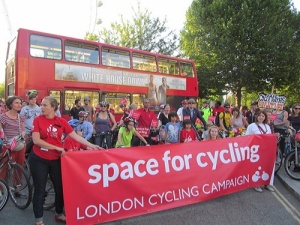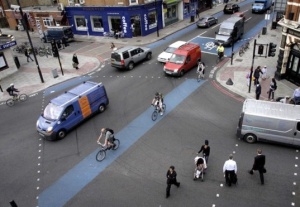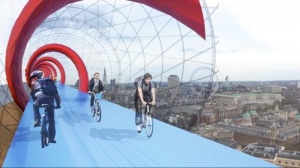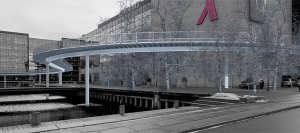As we build up to Adelaide Velo-City Global 2014, the world’s foremost conference on cycling planning; including discussions on the benefits of cycling for city infrastructure – including urban design, traffic planning, economic prosperity & population health – and the role of cycling in better social development, I thought I would comment on the need for safe cycling infrastructure in London, one of the world’s great cities. After all I have seen first hand the enthusiasm for cycling in the city – a considerable influence no doubt coming from the popularity of British Cycling from the Olympics and even the Mayor of London’s initiatives – both as a past time and to commute to work. But I have also witness the real fear that many people have to get on the road with their bikes because of the numerous cyclist deaths which plague the city and it’s morning headlines. I myself smashed all my teeth out of my front jaw (surgeons were pretty sure my obliterated helmet saved me from serious head trauma I must add) from a poorly maintained road surface in South London 2 years ago, so if that adds any weight to these arguments below, please use them to stop the talking and get things done.
London could be one of the great cycling cities and it’s presence at the heart of the world economy, cultural exchanges (it is after all the world’s most diverse city) and global transport connections (we will leave the future of Heathrow airport for another day!) means that it could have a profound influence across the planet – NYC you could even be next! However with these ongoing protests, petitions and preventable cycling deaths in London, a profound sense of reality must fall on *cough* Boris and Mr Cameron, take the same amount of money you spend doing up Buckingham place (no dig at royalty there, promise, just an example), what like 67p per person in the UK and make proper changes to the cycling infrastructure in the capital and a firm inclusion here – the rest of the UK!
 One day after the RideLondon event (3-4 August 2013), where tens of thousands of participants rode through the city in traffic free space, a 67 year old retired GP Clive Richard became the fourth victim on the capital roads in as many weeks to be killed in a fatal collision. A collision which took place, like all the others, on a street where cyclists have to share space with fast-moving heavy motor traffic. This has to stop now. Enough with the debate-MPs will be talking over the Get Britain Cycling report that proposes a host of measures to make cycling safer-it is time to construct Dutch style segregated tracks (Cycling Embassy of Great Britain does a nice job on summarizing the ‘Dutch Cycling Infrastructure‘) alongside cycling specific traffic lights & frankly whatever the London Cycling Campaign proposes!
One day after the RideLondon event (3-4 August 2013), where tens of thousands of participants rode through the city in traffic free space, a 67 year old retired GP Clive Richard became the fourth victim on the capital roads in as many weeks to be killed in a fatal collision. A collision which took place, like all the others, on a street where cyclists have to share space with fast-moving heavy motor traffic. This has to stop now. Enough with the debate-MPs will be talking over the Get Britain Cycling report that proposes a host of measures to make cycling safer-it is time to construct Dutch style segregated tracks (Cycling Embassy of Great Britain does a nice job on summarizing the ‘Dutch Cycling Infrastructure‘) alongside cycling specific traffic lights & frankly whatever the London Cycling Campaign proposes!
The mayor is facing tough questions from several political inquests because simply when you are spending £10million on cycle superhighways while does it normally just consist of blue paint&often to dangerous traffic junctions?
As many cyclists know, the current infrastructure in place is often summarizes as follows (a video entitled ‘A short journey’ by Chris Broadman for British Cycling and put together for the ‘Get Britain Cycling” Parliamentary inquiry in Feb 2013, note another inquiry, talk, chance for our leaders to have yet another meeting)
Being a cycling enthusiast I am drawn to the quotes of activists like Fred Armisen;
“Cars. They’re noisy and ugly. They smell terrible and cause disease on an epidemic proportion. They move way too fast, take up an extraordinary amount of space, are a leech on the economy, and have a propensity to run people over, especially kids. What’s to love?”
But let’s be a bit more diplomatic and put a simple summary list together for the politicians who have that well-complied report in their desk drawer:
[1] No other mode of transport is better value you money.
7.4% of EU citizens use bicycle as their primary mode of transportation although overall investment for the EU-27 on cycling infrastructure and promotion amounts to a measly 3 billion euro annually. The mayor of Portland (Oregon, US and a city considered one of the most cycling friendly urban areas in the country) Sam Adams is on record saying that the entire biking network cost $60million, about the cost of 1 MILE of highway. Further examples were raised in a recent blog from David Suzuki, a Japanese Canadian broadcaster, science broadcaster & environmental activist, including a study by Stantec Consulting Ltd on traffic delays in Vancouver area which showed that travelling by a new bike lane in the city was actually faster than by car. To quote Mr Suzuki ‘As oil becomes scarce and pollution and climate change increase, people are finally realizing that transporting a 90-kilogram person in two tonnes of metal just isn’t sustainable, especially in urban areas’ – that just about sums it up, doesn’t it?
[2] Bicycling’s healthcare savings are huge.
With millions of office workers having no or little exercise week in week out, that commute into work can have huge health benefits (in fact the British Medical Journal found no significant statistical difference between exercise & drug intervention for the treatment of heart failure and stroke – see here – and there is growing evidence that it clinically fights depression. In the US (which is health benefit crazy let’s face it) companies are starting to pay employees cash to bike commute to work including QBP in Minnesota which paid out $45,000 each year, saving $200,000 a year on healthcare claims. Looking globally the WHO even developed a Health Economic Assessment Tool (HEAT) for cycling and estimated that the health benefits of cycling just from reduced mortality was 114-121billion euro annually.
[3] The case for local economic prosperity from increased cycling;
Starting with a visual reference this was a great post by @carltonreid. Executive editor for BikeBiz.com, which demonstrated the economic prosperity for local business because of Cambridge’s love of cycling – and it’s not just the cycling shops but cafés, markets, we have think like a Danish cyclist I suppose.
On an academic scale, even the conservative fiscally arguments for bicycle infrastructure are numerous. A 2009 British study found that just a small number of additional regular riders is needed to repay the cost of new cycling infrastructure. In this research it was determined that an infrastructure investment equivalent to 10,000 pounds would be recouped over the life of the facility by enticing just one additional cyclist to ride 3 times a week. Furthermore a 2006 analysis by Sustrans, a major non-profit organization working for sustainable transportation in partnership with the U.K. government, demonstrated that the benefit-cost ratio of cycling infrastructure averaged 20 to 1 including estimated health savings. Across the pond, an Ottawa Cycling Plan, called for $26 million over 5 years, recognizing that it would entirely pay for itself with about 2,200 new regular cyclists. References for these and numerous other studies can be found at this great blog
To give even more weight to this argument; building bike lanes creates jobs and other economic spin-offs, with many researchers arguing that more of the money on road-building efforts goes towards equipment and materials rather than a greater percentage on wages as with bicycle lanes. According to a study from the Political Economy Research Institute in Amherst, Massachusetts, titled “Pedestrian and Bicycle Infrastructure: A National Study of Employment Impacts”. Researchers found that “bicycling infrastructure creates the most jobs for a given level of spending.” For every $1 million spent, cycling projects created an average of 11.4 jobs in the state where the project was located, pedestrian-only projects created about 10 jobs, and multi-use trails created about 9.6 jobs. Infrastructure combining road construction with pedestrian and bicycle facilities created slightly fewer jobs for the same amount of spending, and road-only projects created the least, with a total of 7.8 jobs per $1 million.
And of course the list of benefits for cycling extend even further, including: reduced air and noise pollution, low demand on scarce (urban) space, a small carbon footprint, reduced fuel dependency etc etc. Because of this blindness to behaviour change, we in the UK are missing out on the vast societal beneifts of sustainable transport . And so the question is while do our inner city transport planners insist on giving space to car traffic – even with all the negative consequences of our car-centric culture – when it has been proven that cycling has dramatic health and social benefits, and in many cases gets you at your office desk faster & stop your boss shouting at you for being late? Cycling must be prioritized in city planning, with serious targets on reducing serious injuries or death, as well as targets for safety, comfort, and speed. Future planning needs to call for rebuilding streets and intersections throughout the city and identify especially dangerous intersections. This all in tandem with safety and behavioural campaigns and resetting the mindset of motor traffic leaders in TfL.
To get a bit inspiration about it all, I always enjoy the quote:
“When man invented the bicycle he reached the peak of his attainments. Here was a machine of precision and balance for the convenience of man. And (unlike subsequent inventions for man’s convenience) the more he used it, the fitter his body became. Here, for once, was a product of man’s brain that was entirely beneficial to those who used it, and of no harm or irritation to others. Progress should have stopped when man invented the bicycle. ” – Elizabeth West
Or to get a bit more ‘scientific’ about it all this is a quote from a systemic review in the British Medical Journal Clinical Research Edition on ‘Inventions to promote cycling’
Considering cycle lanes are waste of money and cycle tracks are inherently dangerous you should have no problem pointing out another report of comparable research that shows leaving out cycle lanes and cycle tracks would have resulted much more significant results.
Yang, L. et al., 2010. Interventions to promote cycling: systematic review. Bmj Clinical Research Ed., 341(c5293).
So what should we do?
Well first of all let’s stop all this talking. Sign the checks and get going. $60 million was the price quoted for Portlands cycling infrastructure (granted not a world leading city for cycling but that price tag goes a long way to build dedicated cycling routes) let’s put together a list of 3 white elephant projects or other resultless pursuits that resemble that figure or totally eclipse it – aka lets show that money is there, or shall we say should be and is being wasted. These are some notable ‘red’ projects (which are at serious risk of failure) as drawn up by the Government’s own Major Project Authority:
1. £34 billion on HS2 rail link from London to Manchester. Granted I think railways are an excellent way to get people off the roads (although I think the money would be better spent of higher capacity, eg double decker trains, Mr Prime Minister ever been standing for 5 hours all the way to Edinburgh in the corridor next to the toilet on your rail network?). Surely it is not too much to ask for segregated cycle lanes in probably the world’s greatest city – as already mentioned before this cuts down depression, is the most efficient way for mass transport of commuters, improves air quality etc etc.
NB and with this focus on rail transport can we also note the importance of the ability to bring bikes on a train. Not much point getting the UK active if you can only book 3 bikes on the train to the Lake District and so have to drive up – that’s a reference to you Virgin a Trains and the governments west coast franchise people (you get your own grilling in a sec)
2. West Coast Main Line franchise fiasco set to cost 50million mainly because the contract procedure wasn’t drawn up correctly – or at least that’s what I recall on the stupid fiasco, won’t waste my time looking it up more.
3. And of course this marble elephant – The failure of the FiReControl project – 469 million wasted according to the National Audit Office
Safe, segmented cycle lanes in London should be absolutely priority for any regional Government and before we laugh at some of the SkyRides proposed by the Boris and his office (some great thinking coming from that office really, just need to put the hard cash down & get going), just do a little research on those networks already in existance. Copenhagen for one has elevated bikeways and multilane highways. You can even used disused railway lanes as Boris has mentioned in interviews. Of course it is not all bad news, there have been progress in developing one way street into cycle lanes. Only this August the Department of Transport allocated 3.7million (in addition to the 1.8million of local money) to upgrade cycling infrastructure across Norwich and additionally there is the Bristol to Bath railway path. Yet really for the financial investment in motor travel these steps are really tiny – indeed there has been criticism that by focusing on small cycle lanes and not on establishing main routes you are causing a risk of further injuries (don’t groan road users, our income tax subsidies road infrastructure – yes that’s right your road tax doesn’t cover it all).
With TfL estimating that cycling journeys will treble by 2020 (certainly if the Tube price keeps going up!) we need to get going on putting this cycling infrastructure into place. However as clearly pointed out by the London Cycling Campaign (LCC) there has been countless urban improvement schemes which have been vetoed by TfL, with the focus on maintaining motor traffic capacity. All this in the face of an increasing body of compelling evidence from London, UK, Netherlands, EU and the USA that shows that installing high-quality cycling facilities increase the capacity for traffic on our streets. On that note this is a great interview with Peter Murray, LCC’s chair of New London Architecture and organizer of the London Cycle Summit – link
As the LCC keeps commenting, it’s desperately sad that so many urban improvement projects – Aldgate, Blackfriars, Elephant & Castle and Vauxhall – are vetoed because it’s not accepted that people can switch from one mode of transport to another. To get functional, safe cycling lanes a reality in London, why doesn’t the Mayor and his cycling commissioner, Andrew Gilligan give Chris Broadman and the folks at British Cycling (namely the new officer for cycling infrastructure and development) 60million and a strong mandate to force transport for London to implement the proposals with immediate effect. This cycling institution knows exactly what it talking about – leave the elected politicans get the money together and perhaps chair some of the meetings (thats my little compromise). Boris and Mr Cameron I am pretty sure you haven’t cycled across the UK, so I don’t think you have much of the know how to recognize what a nationwide cycling network needs. Leaders such as Boris need to stop focusing on getting the newspaper headlines – I saw this one on E-bikes been mentioned by Boris recently [ Great opinion article here – ‘Before we go electric let’s get back to basics’ ] and just sign the checks. Additionally we might also want to work on that little bit of cyclist-driver tension……a particular scheme article here
And if you question whether this is all possible the 2006-2016 cycling plan in Copenhagen has been estimated to cost DKK 400million or about 45 million pounds and will form over 70km of new cycle tracks and cycle lanes -there is only 560,000 people living in the city, why can’t London afford anything near this investment?
P.S. [If you want further reading on this topic check out: Infrastructure that will power cycling revolution]



